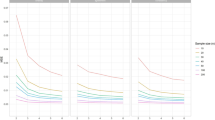Abstract
The randomized available case study, in which a nonrandom set of cases (patients, animals, laboratory runs) is randomized among two or more treatments, is a staple of biomedical research. Traditionally, such studies have been analyzed as though the cases were a random sample from an infinitely large population (1). The resulting statistical inferences address incorrect populations. More importantly, in the presence of response measurement error these inferences are inappropriate for the correct populations, understating the differential impact of treatment (2). In this paper I develop and illustrate a nonparametric bootstrap approach to inference in such studies, an approach that is faithful to the local origins of the randomized cases and can account for the influence of measurement error.
Similar content being viewed by others
References
Ludbrook J, Dudley H. Why permutation tests are superior to t and F tests in biomedical research. Am Statistician. 1998;52:127–132.
Reichardt CS, Gollob HF. Justifying the use and increasing the power of a t test for a randomized experiment with a convenience sample. Psychological Met. 1999;4:117–128.
Edgington ES. Randomization Tests. 3rd Edition. New York: Marcel Dekker; 1995.
Good PI. Permutation Tests: A Practical Guide to Resampling Methods for Testing Hypotheses. 2nd Edition. New York: Springer; 2000.
Lunneborg CE. Data Analysis by Resampling: Concepts and Applications. Pacific Grove, CA: Brooks-Cole; 2000.
Rubin DR. Comment: Neyman (1923) and causal inference in experiments and observational studies. Stat Sci. 1990;5:472–480.
Rubin DR. Formal models of statistical inference for causal effects. J Stat Planning Inference. 1990;25:279–292.
Rubin DR. Practical implications of modes of statistical inference for causal effects and the critical role of the assignment mechanism. Biometrics. 1991;47:1213–1234.
Wilkinson L. The Task Force for Statistical Inference. Statistical methods in psychology journals: guidelines and explanations. Am Psychologist. 1999;54:594–604.
Elfron B, Tibshirani R. An Introduction to the Bootstrap. New York: Chapman & Hall; 1993.
Davison AC, Hinkley DV. Bootstrap Methods and Their Applications. Cambridge: Cambridge University Press; 1997.
Chernick MR. Bootstrap Methods: A Practitioner’s Guide. New York: Wiley; 1999.
Neyman J. On the application of probability theory to agricultural experiments: essay on principles. Section 9. Statistical Sci. 1990;5:465–472.
Efron B. Bootstrap methods: another look at the jackknife. Ann Stat. 1979;7:1–26.
Booth JG, Butler RW, Hall P. Bootstrap methods for finite populations. J Am Stat Assoc. 1994;89:1282–1289.
Anastasi A. Psychological Testing. London: Collier MacMillan; 1982.
MathSoft. S-Plus user’s guide. Seattle: Data Analysis Products Division, MathSoft, Inc.; 1999.
Hand DJ, Daly F, Lunn AD, McConway KJ, Ostrowski E. A Handbook of Small Data Sets. London: Chapman & Hall; 1994.
Author information
Authors and Affiliations
Corresponding author
Rights and permissions
About this article
Cite this article
Lunneborg, C.E. Bootstrap Inference for Local Populations. Ther Innov Regul Sci 35, 1327–1342 (2001). https://doi.org/10.1177/009286150103500429
Published:
Issue Date:
DOI: https://doi.org/10.1177/009286150103500429




